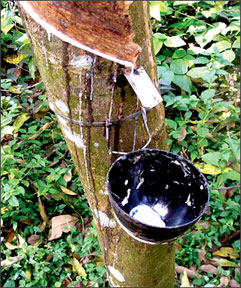Rubber growers donít reap maximum benefits -RRI Director
By Gamini Warushamana
[email protected]
 Sri Lankaís rubber growers have failed to achieve the maximum
benefits from the bonanza in the natural rubber sector, Director, Rubber
Research Institute (RRI) Dr. Ashoka Nugawela told the Sunday Observer. Sri Lankaís rubber growers have failed to achieve the maximum
benefits from the bonanza in the natural rubber sector, Director, Rubber
Research Institute (RRI) Dr. Ashoka Nugawela told the Sunday Observer.
Today, natural rubber in the raw form is trading at around Rs. 250
per kilogramme. The price will increase further since the supply cannot
meet the demand.
However, rubber growers are not reaping the maximum benefit and the
national productivity level is half its potential, he said.
At present the national productivity level is around 1,150 kg per
hectare per year, significantly lower than the potential. Therefore, the
majority of the rubber growers are not making the maximum benefit from
this golden opportunity.
A rubber grower could obtain around 1,000 kg yield per acre per year
from a well managed plantation. At the current farm gate price this
amount of rubber has a value of Rs. 250,000. However, the majority of
our rubber growers get only around 500 kg per acre per year, and
therefore the value is just half its potential.
Despite the attractive rubber prices productivity levels of both
smallholder and plantation sectors seem to be increasing at a very slow
rate.
Growers should endeavour to adopt the agronomic practices that are
capable of giving high productivity levels and obtain the maximum
benefits from the current attractive trading conditions, he said.
Dr. Nugawela said that even with such sub optimal land productivity
level rubber growers are reaping reasonable profits and there is a lot
of enthusiasm in investing in rubber cultivation.
However, today the profits are driven by the natural rubber prices
and not by the optimal yield by better management and enhanced
productivity. If we could achieve the latter as well we could maximise
profitability and sustain profitability even under adverse trading
conditions.
The year 2007 was a good year for the industry and the natural rubber
production in the country increased up to 117,600 metric tons, a 7.3%
increase compared to the 2006 production of 109,600 MT.
Encouraging price signals have marginally improved the productivity
in rubber cultivation. According to data the total rubber extent of the
country is 120,070 Ha and assuming 80% of the extent is mature rubber,
the national productivity level for the year is around 1,225 kg of
rubber per hectare per annum, a 6.5% increase compared to 1,150 kg of
rubber per hectare per annum in 2006.
Rubber prices remained attractive during the whole year and the
average price for RSS 1 ranged from Rs. 268-187 per kg and for latex
crepe 1X it was between Rs. 276-210 per kg.
New and replanting of rubber by growers has reached a very high
level. Dr. Nugawela said that the RRI has revised its clone
recommendation for potential growers to have a better choice of high
yielding clones.
However, the availability of land in traditional rubber growing areas
is a constraint to increase the rubber extent in the country.
Hence research and development work is being continued to expand
rubber cultivation into other parts of the country. Potential growers
from the Anuradapura and Polonnaruwa Districts too have requested for
advice from the RRI regarding rubber cultivation.
Field trials of rubber cultivation in the Eastern province have been
successful and smallholders are enthusiastic.
The field trials upcountry for rubber cultivation have also been
successful and large estate companies are interested in transforming
infertile and abandoned tea lands to rubber. Watawala Plantations has
already started a project. However, there is no interest from
smallholders in this sector, he said. |
